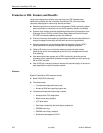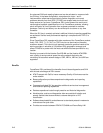
About the FrameSaver DSL Unit
1-10
9783-A2-GB20-00
July 2000
H LMI Packet Capture. Provides a way of uploading data that has been
captured in a trace file so the data can be uploaded and transferred to a
Network Associates Sniffer for analysis, or viewed via the menu-driven user
interface. When viewed from the menu-driven user interface, the 12 most
recent LMI messages are displayed.
Advanced SLV Features
The following additional features are provided with the advanced SLV feature set:
H TruePutt Technology. Using Frame Delivery Ratios (FDR) and Data
Delivery Ratios (DDR), throughput (within and above CIR, as well as between
CIR and EIR, and above EIR) can be measured precisely, eliminating
inaccuracies due to averaging.
H Intelligent Service Level Verification. Provides accurate throughput,
latency, and availability measurements to determine network performance
and whether SLAs (Service Level Agreements) are being met, along with
SLA reporting.
H RMON Alarms and Configurable Alarm Thresholds. Provides the ability
to change SLA parameter and RMON alarm thresholds via the OpenLane
system to correct them in real-time, before the SLA is violated.
H Multiplexed Customer PVCs. Provides a method of multiplexing customer
management data and user data with network management data
transparently over a single PVC (Permanent Virtual Circuit) when
FrameSaver devices are at each end of the circuit.
H FTP User History Poller. Provides a bulk collector using FTP through the
OpenLane system that generates a file for data at the time that data is
uploaded using FTP.
H RMON-Based User History Statistics Gathering. Provides everything
needed to monitor network service levels, plus throughput with accurate data
delivery, network latency, and LMI and PVC availability. Continuous roundtrip
latency testing and reporting, as well as CIR to transmitted and received data
performance statistics, are included.
In addition, port bursting statistics are kept for all frame relay links for
accurate calculation of utilization.
H Network User History Synchronization. Allows correlation of RMON2
User History statistics among all SLV devices in a network. Using a central
clock, called the network reference time, all SLV device user history statistics
are synchronized across the network, further enhancing the accuracy of
OpenLane SLV reports.
See
OpenLane SLM System
for additional information.


















